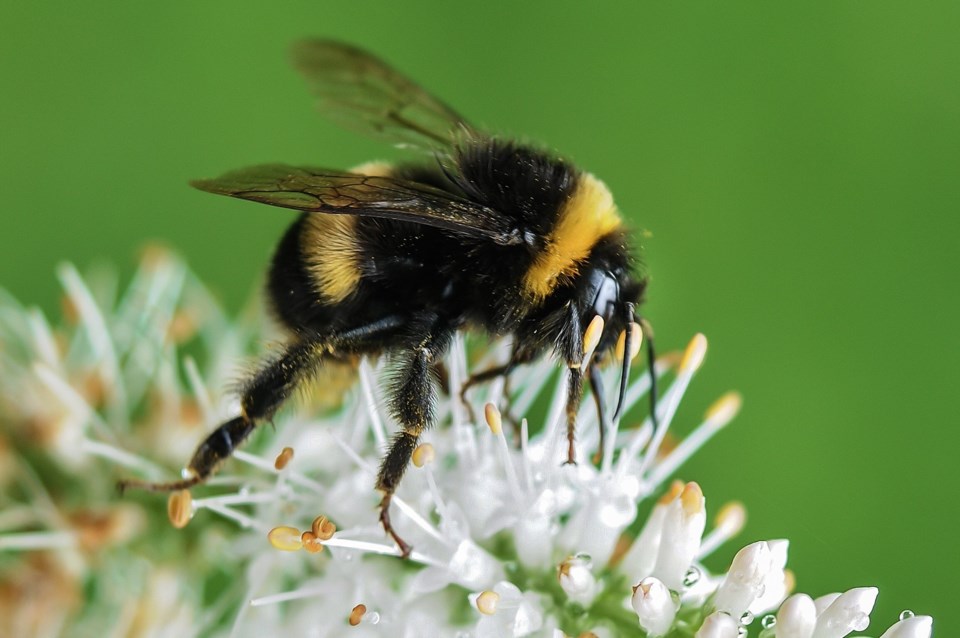With the recent rise of campaigns like “Save the Bees” and delegations urging city councils to designate their city as a “Bee City”, interest in bees is buzzing. The attention is legitimate. Of the main crops that we consume as food sources, 70% of them require pollination to produce the food; berries, nuts, fruit and vegetables. Global monitoring indicates that bee populations are declining due to a variety of reasons – dissapearance of habitat, pests and diseases, pesticides, and climate change. The discussion is a political football but the increased awareness can do no harm.
Globally, there are up to 30,000 species of bees, depending on your source of information, with about 850 native to Canada. Bees can be divided into two categories: ‘social’, those bees that live in colonies or hives and work together for one fertile queen bee, and ‘solitary’, those that do not swarm but live and lay eggs alone in a cell and all the females are fertile. We are most familiar with the social bees, the bumble bee and the honey bee, but they only account for 10% of the population. 90% of our bee population is the solitary bee which includes the lesser known mason and leafcutter bees. The important difference is that the solitary bee is 100 times more effective as a pollinator than the social or honey and bumble bee. The additional bonus is that the solitary bee rarely stings. You would really have to be endangering it’s life for it to strike back and if it does, it hardly hurts as it has no venom and thus does not induce an alergic or anaphylactic reaction.
Solitary bees are much less aggressive than honey bees because they do not have a hive full of honey to defend. Solitary bees only sting as a last resort to defend. Male bees of any bee species do not have stingers. Mason and leafcutter bees are so gentle that you can stand at the entrance of their nesting house and watch them come and go and they won’t bother you. Solitary bees hibernate during the winter and they don’t produce honey. As an effective pollinator, they are better able to distribute the pollen flower to flower than honey bees because of the way they carry dry pollen on their body. Honey bees dampen the pollen with their saliva so it sticks to its hind legs and can be carried back efficiently to the hive, feeding thousands of bees. Solitary bees, on the other hand, only lay around 20 eggs in their lifetime.
Every solitary female bee is fertile and it is her sole responsibility to gather food and provide protection for her eggs. She keeps busy mating, building her nest, and gathering nectar and pollen to feed her young. Even though the bees live on their own, they are very friendly and gregarious, which means they enjoy living next to other solitary bees. Mason and leafcutter bees are hole-nesting bees that build nesting chambers for each of their eggs in pre-existing holes or cavities. Within each nesting chamber the egg hatches,develops, and forms a cocoon for over-winter hibernation. A nesting house provides the bees and their nesting holes with the protection they need from rain, wind, and when necessary, large predators. A hole-nesting female bee chooses her nesting hole and marks it with her own unique scent; producing a slight citrus or lemon scent. Beginning at the back of their chosen nesting hole, the female bee begins a cycle of building nesting chambers that are made up of food for the egg (a pollen and nectar loaf), an egg, and a protective layer of nest-building material. When the last nesting chamber is finished she packs the last space with extra-thick layer of protective mud, leaves, or other materials called a ‘capped end’.
Solitary bees have the ability to decide the sex of their offspring. A female bee will fertilize an egg to enable that egg to develop into a female bee. Eggs that are not fertilized will develop into male bees. Both mason and leafcutter bees protect their female offspring by fertilizing eggs that are at the interior of the nesting hole so that the female eggs are farthest away from the nesting hole opening. Male eggs will be laid near the front of the nesting hole and this ensures that male bees emerge first and are ready to mate when the female bees emerge.
Mason bees emerge in cool spring weather (50°F/10°C) and are superior pollinators of apple, cherry, pear, almond, peach, kiwi, nuts, and berries and also great pollinators of early spring-blooming flowers. Leafcutter bees emerge in warm summer weather (70°F/21°C), and are superior pollinators of melons, squash, cucurbits, peas, and other summer vegetables and flowers. Alfalfa leafcutter bees are commercialized across North America as an integral part of alfalfa seed production farms.
All of these characteristics make mason and leafcutter bees a perfect choice for pollinating backyard gardens, farms, and orchards. It’s easy to establish a habitat for the solitary bee. Habitat kits and the necessary accessories are available at The Green Spot Home & Garden. Kits run up to $80 or you can buy all the pieces individually, houses, reeds, tubes or wood trays, and mud. $20 buys 10 cocoons (6 male and 4 female) Mason and leafcutter bees have a short flying range of 300 feet (100 meters) so install a bee nesting house where you need pollination.
With 1 to 2 hours per year, a back yard gardener can raise and take care of solitary bees. You’ll probably spend more time standing at their house watching the bees come and go. It’s an activity that the whole family can enjoy.




